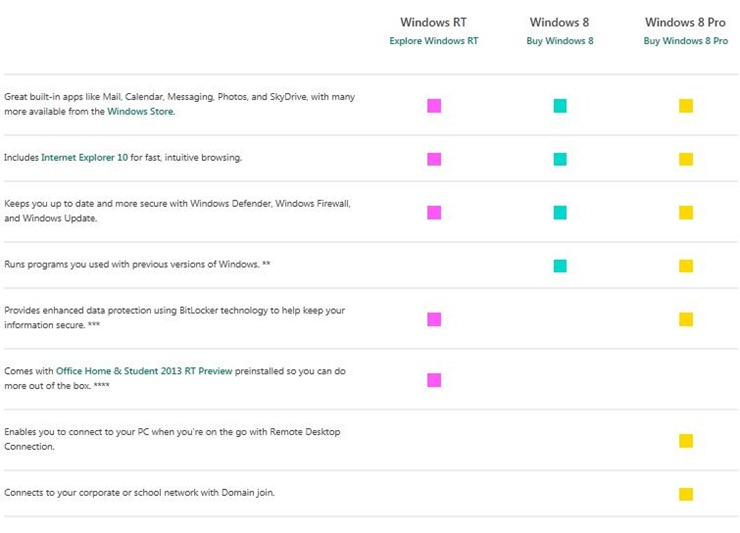Upgrade and Migration: Requirements for a fresh install of Windows 8 (Part 1 of 19)
In by now, I’m sure everyone has seen commercials and pricing on lots of new computers, laptops and tablets with Windows 8 preinstalled. If you’re not in the market to buy a new computer, but want to get to Windows 8 installed on your existing computer, then you’ll need to know the requirements and options. There are two options – in-place upgrade your existing Windows 7 computer or install a fresh new copy of Windows 8. Either way, there are system requirements that you need to meet.
Following are the official minimum requirements in order to run Windows 8:
- Processor: 1 gigahertz (GHz) or faster with support for PAE, NX, and SSE2 (more info)
- RAM: 1 gigabyte (GB) (32-bit) or 2 GB (64-bit)
- Hard disk space: 16 GB (32-bit) or 20 GB (64-bit)
- Graphics card: Microsoft DirectX 9 graphics device with WDDM driver
Now that we got the “minimums” out of the way, let me give you “Harold’s” recommendations on the two items that seem totally out of whack to me:
- RAM: 4 gigabyte (GB) (32-bit or 64-bit)
- Hard disk space: 100 GB (32-bit or 64-bit)
Most new computers that I’ve seen in the last three years have already been coming standard with four GB of RAM or more. If you plan on installing applications, then you definitely need more than 20 GB of free hard disk space. The amount of free space you need will depend on how many apps you choose to install. For the best performance, you can always go with the solid-state drive (SSD). These are more expensive, but may be worth the money. As an example, I purchased a 256 GB Samsung SSD drive for about $250. Also keep in mind, not all drives are made equal so be sure to check out the specs before you purchase.
Depending on the features that you use there may be some additional requirements. I am listing them below:
- To use touch, you need a tablet or a monitor that supports multitouch (more info)
- To access the Windows Store and to download and run apps, you need an active Internet connection and a screen resolution of at least 1024 x 768
- To snap apps, you need a screen resolution of at least 1366 x 768
- Secure boot requires firmware that supports UEFI v2.3.1 Errata B and has the Microsoft Windows Certification Authority in the UEFI signature database
- Some games and programs might require a graphics card compatible with DirectX 10 or higher for optimal performance
- Microsoft account required for some features (such as accessing the Windows Store)
- Watching DVDs requires separate playback software (more info)
- Windows Media Center license sold separately (more info)
- BitLocker To Go requires a USB flash drive (Windows 8 Pro only)
- BitLocker requires either Trusted Platform Module (TPM) 1.2 or a USB flash drive (Windows 8 Pro only)
- Client Hyper-V requires a 64-bit system with second level address translation (SLAT) capabilities and additional 2 GB of RAM (Windows 8 Pro only)
- A TV tuner is required to play and record live TV in Windows Media Center (Windows 8 Pro Pack and Windows 8 Media Center Pack only)
- Free Internet TV content varies by geography, some content might require additional fees (Windows 8 Pro Pack and Windows 8 Media Center Pack only)
To check if your PC meets these requirements, you can run the Upgrade Assistant.
To actually start the installation, you will either need a DVD with Windows 8 or a bootable USB with Windows 8. Once the setup starts, you will also need to have a valid product key to continue.
Remember, a fresh install means you are wiping the hard drive and installing a fresh copy of Windows 8, and then reinstalling all your applications afterwards. If you are already running Windows 7, have all your applications installed and want to keep all the settings and all the applications, then you’ll want to do an in-place upgrade to Windows 8. Please make sure you select the correct option.
I happen to be of the “old school” mindset – I don’t do in-place upgrades if I can avoid it. One exception I have for this is my Media Center machine - if I don’t do an in-place upgrade, I will not be able to watch any of my previously recorded shows.
The final thing I will leave you with is a quick comparison of the editions of Windows 8. I am including Windows, RT, even though you can only buy that preinstalled on a new machine.
Harold Wong

